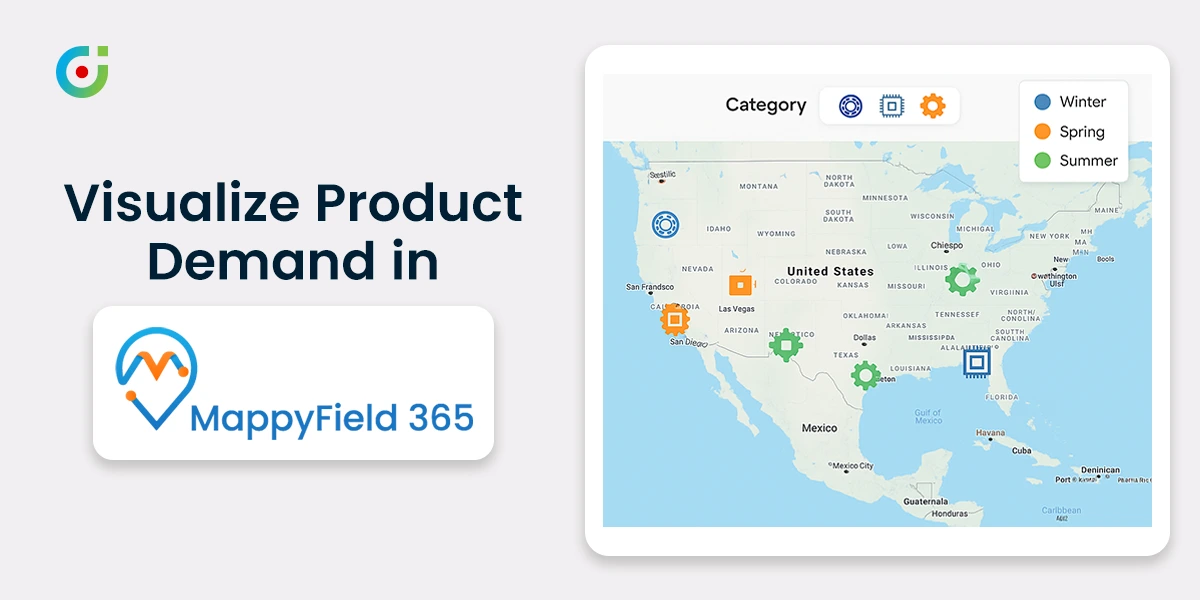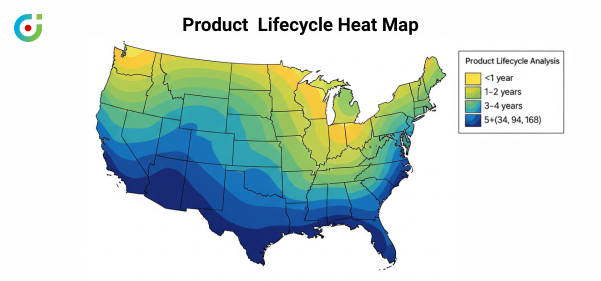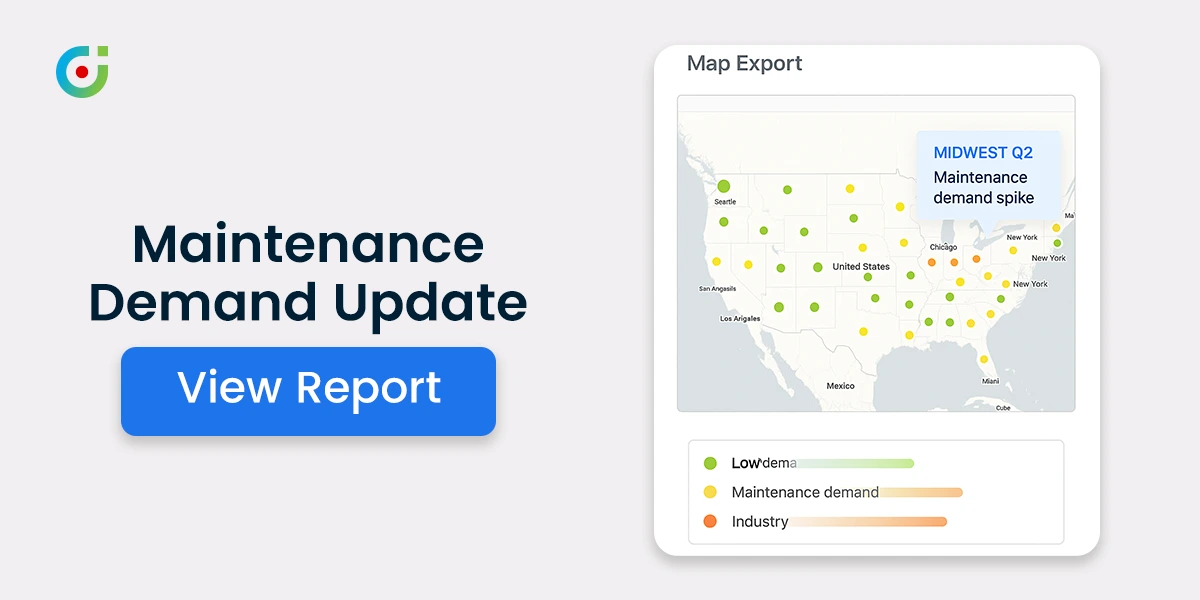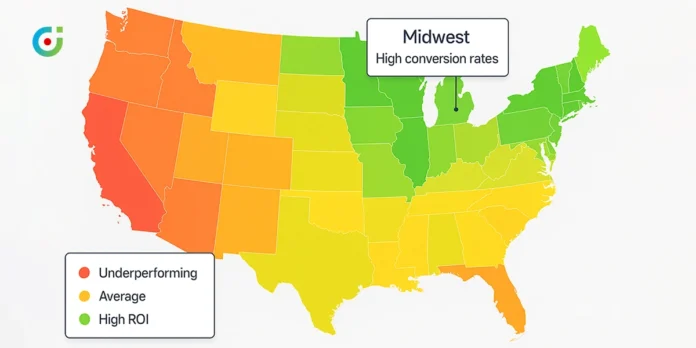“Last quarter, we invested $200K in a manufacturing campaign. The results were telling. Dallas exceeded expectations significantly. Phoenix delivered moderate results. Chicago underperformed badly.”
This scenario repeats itself every quarter across manufacturing companies. You launch campaigns with high hopes, then wait to see what happens. Some regions deliver excellent results, others disappoint. The reasons remain unclear.
Three challenges consistently impact your campaigns:
Regional sales performance varies dramatically. A campaign that works exceptionally well in one market can fail completely in another. We’re making decisions without adequate geographic context.
Sales cycles in manufacturing are lengthy. Someone engages with content in January, we nurture them through spring, and they might purchase in July. Connecting marketing activities to final sales outcomes becomes difficult.
Post-campaign follow-up lacks geographic focus. The CRM shows engagement metrics, but doesn’t help us understand where prospects are located or how to reach them effectively. Many qualified leads get lost in the process.
MappyField 365 addresses these challenges by integrating with your existing Dynamics 365 CRM manufacturing setup and adding geographic intelligence to your marketing data. This manufacturing marketing automation solution doesn’t require adopting a new platform. You’re enhancing what you already have with geospatial CRM tools for Dynamics.
The difference is significant: Campaigns that target the right regions effectively, follow-ups that make geographic sense, and ROI tracking that connects marketing activities to sales outcomes. Plus you can analyze historical data to avoid repeating costly mistakes.
Why Geographic Intelligence Matters Now
Customer expectations have evolved. They want relevant communications that address their specific needs and location. Generic product emails don’t resonate anymore. They want solutions that make sense for their business context.
Marketing budgets face increased scrutiny. Finance teams want to understand why every campaign didn’t deliver exceptional ROI. Each dollar needs to work harder and produce measurable results.
Traditional CRM segmentation provides demographics and behavioral data. But it misses a crucial element: Where customers actually operate their businesses. Location significantly impacts timing, needs, and purchasing decisions.
MappyField 365 bridges this gap with powerful Dynamics CRM location intelligence. It takes your Dynamics 365 data and reveals geographic patterns that were previously invisible. You discover opportunities that were present all along.
You’re not replacing existing systems. You’re making them more effective by adding location context that drives better marketing decisions.
Extracting Value from Historical Campaign Data
Most organizations have years of campaign data stored in Dynamics 365. Getting geographic insights from this information typically requires extensive manual analysis and complex reporting.
MappyField 365 transforms this into a straightforward process with CRM-integrated heatmaps. You can visualize past campaign performance by region within minutes. High-performing areas become immediately apparent. Problem regions are clearly identified.
Here’s a practical example:
A machinery manufacturer analyzed their Q1 campaigns from the previous year using MappyField’s heatmap visualization. The Midwest showed consistently strong performance while the West Coast showed poor results. Midwest campaigns converted 40% better than the national average.
They developed a spring promotion specifically targeting Midwest customers. The results were impressive: 35% better ROI compared to their standard broad-reach approach.
You can identify seasonal patterns as well. Agricultural equipment might sell better in farming regions during the planting season. Industrial tools could peak in manufacturing areas during budget cycles.
Professional tip: Use campaign tagging and time-based filters to identify patterns. You’ll discover natural buying cycles that align with regional business rhythms.
For executives, this means historical data becomes actionable when you add geographic context. Instead of guessing about regional preferences, you make decisions based on proven performance.
Leveraging Component-Level Marketing Intelligence
Manufacturing marketing involves complex products with multiple components. Your CRM contains detailed part-level sales data, but connecting this information to geographic trends requires sophisticated analysis.
MappyField 365 simplifies this process considerably. You can map which parts sell best in specific regions and seasons. This enables targeted campaigns for bundles, upsells, and spare parts that match actual regional demand.

One manufacturer discovered that hydraulic seals consistently showed high demand in the Southeast during summer months. They launched a targeted summer promotion and saw sales increase by 28% in that region.
The same approach works for maintenance parts, seasonal components, and region-specific product variations. You can create heatmaps using part numbers to align marketing materials with real field trends.
Professional tip: Use part-level filters to create heatmaps showing what actually sells in each region. This helps you promote the right products to the right markets at optimal times.
For leadership, this translates to smarter inventory decisions and improved marketing ROI. Instead of broad product promotions, focus resources on what actually drives sales in each market.
Optimizing Product Lifecycle Campaigns
Your installed base represents your largest sales opportunity. However, identifying customers ready for upgrades requires analyzing product age, installation dates, and usage patterns across different geographic regions.
MappyField 365 visualizes this data geographically. You can identify regions where products are aging or approaching replacement cycles. This enables proactive outreach to customers before they begin evaluating alternatives.

A power tools company used this approach to identify areas with high concentrations of equipment over five years old. They launched a targeted buyback and upgrade program in these regions, achieving 45% better response rates than their standard renewal campaigns.
The platform displays product age as geographic overlays. Darker shading indicates older products, while lighter areas show recent installations. You can spot upgrade opportunities at a glance.
Professional tip: Layer product age data with territory density to identify clusters suitable for bulk campaigns or roadshows. This helps you plan efficient field marketing activities that maximize face-to-face selling opportunities.
Strategically, this transforms reactive customer service into proactive revenue generation. You’re not waiting for customers to experience problems. You’re anticipating their needs and positioning solutions in advance.
Empowering Channel Partners with Regional Intelligence
Your distributors and dealers need local market intelligence to succeed. Many manufacturers struggle to provide partners with actionable, region-specific insights that drive sales performance.
MappyField 365 addresses this challenge by enabling you to share geo-based reports directly with channel partners. They receive tailored marketing materials based on their specific geographic territories.

A parts supplier identified increased maintenance parts demand in the Midwest during Q2. They shared this intelligence with Midwest partners through embedded maps and regional statistics. Partners adjusted inventory levels and launched targeted promotions.
The result was a 22% increase in partner sales during the targeted period.
Professional tip: Export maps and regional statistics directly from MappyField for partner communications. This positions your company as a strategic partner rather than just a supplier.
This approach strengthens channel relationships while improving overall market coverage. Partners appreciate receiving actionable intelligence that helps them succeed in their local markets.
Strategic Benefits for Manufacturing Organizations
Adding geographic intelligence to your marketing creates several competitive advantages:
Enhanced ROI through targeted execution: Instead of broad campaigns with mixed results, you concentrate resources on high-opportunity regions and customer segments.
Improved conversion through relevance: Location-based campaigns feel more relevant to customers because they address specific regional needs and preferences.
Better marketing and sales alignment: Shared geographic views create a common understanding between teams. Everyone sees the same regional opportunities and can coordinate efforts accordingly.
Optimized event and launch planning: Geographic intelligence helps you select optimal locations for trade shows, product launches, and promotional events.
These benefits compound over time. Each campaign provides additional data for future geographic analysis. Your marketing intelligence becomes more sophisticated and accurate with every iteration.
The Strategic Imperative
Geographic intelligence isn’t just a nice-to-have anymore. Manufacturing companies that ignore location data are leaving money on the table. Your competitors are already using geographic insights to outmaneuver you in key markets.
MappyField 365 takes the CRM data you’re already collecting in Dynamics 365 and makes it actually useful for geographic decisions. No process overhauls. No expensive data purchases. Just smarter insights from what you already have.
What you get is concrete: Conversion rates that actually improve, marketing spend that goes to the right places, channel partners who perform better, and campaign results you can predict with confidence.
Your marketing team isn’t lacking data. They’re drowning in it. MappyField 365 helps them see patterns and opportunities they’re missing right now. Better decisions follow naturally.
Want to see this in action? Schedule a demo and we’ll show you exactly how MappyField 365 works with your current Dynamics 365 setup. No sales pitch. Just a real look at what geographic intelligence can do for your manufacturing marketing.
All product and company names are trademarks™, registered® or copyright© trademarks of their respective holders. Use of them does not imply any affiliation with or endorsement by them.
